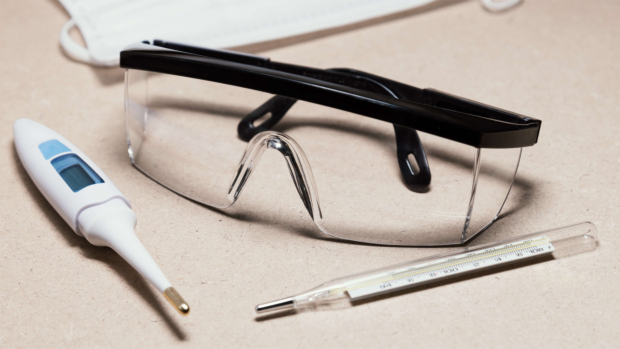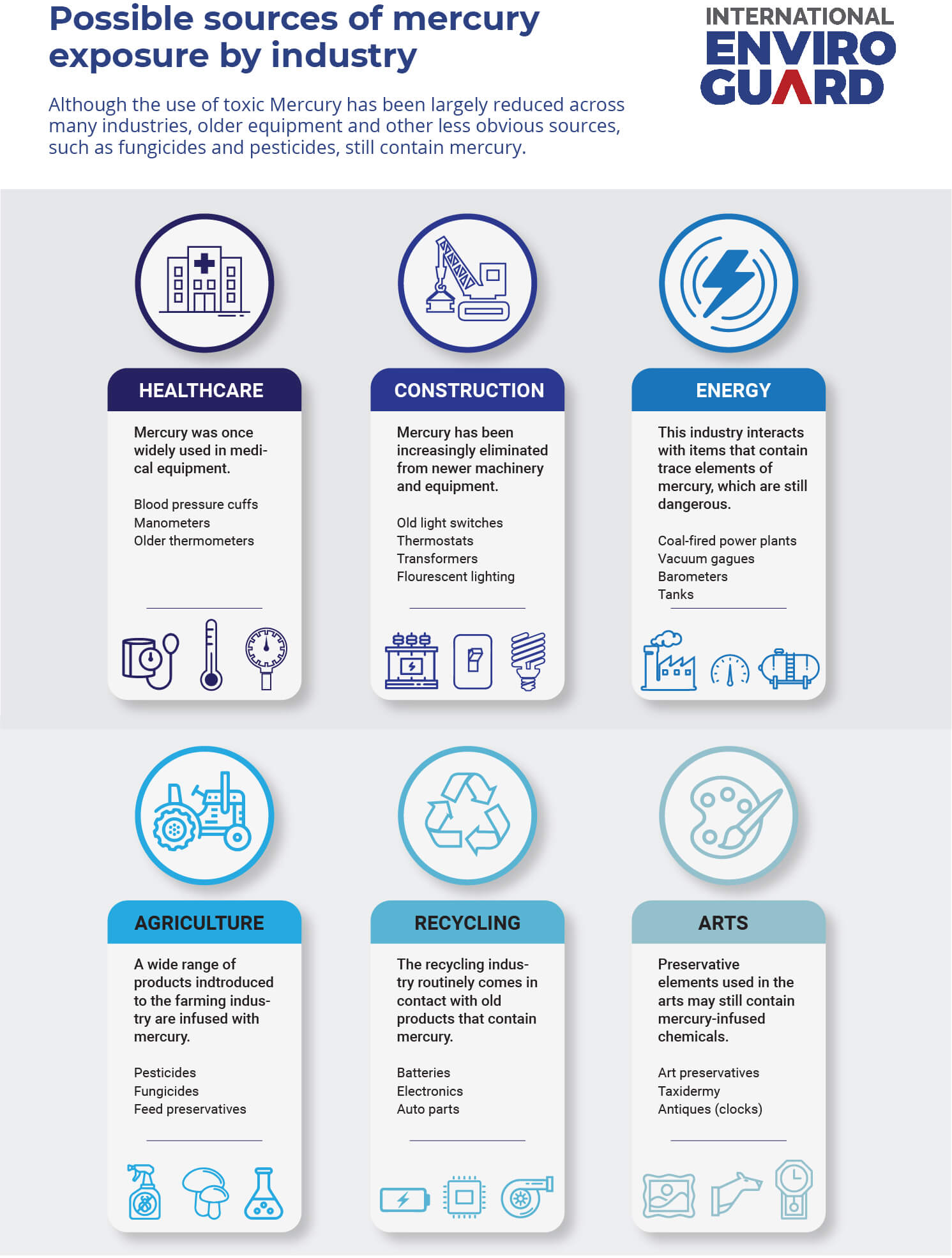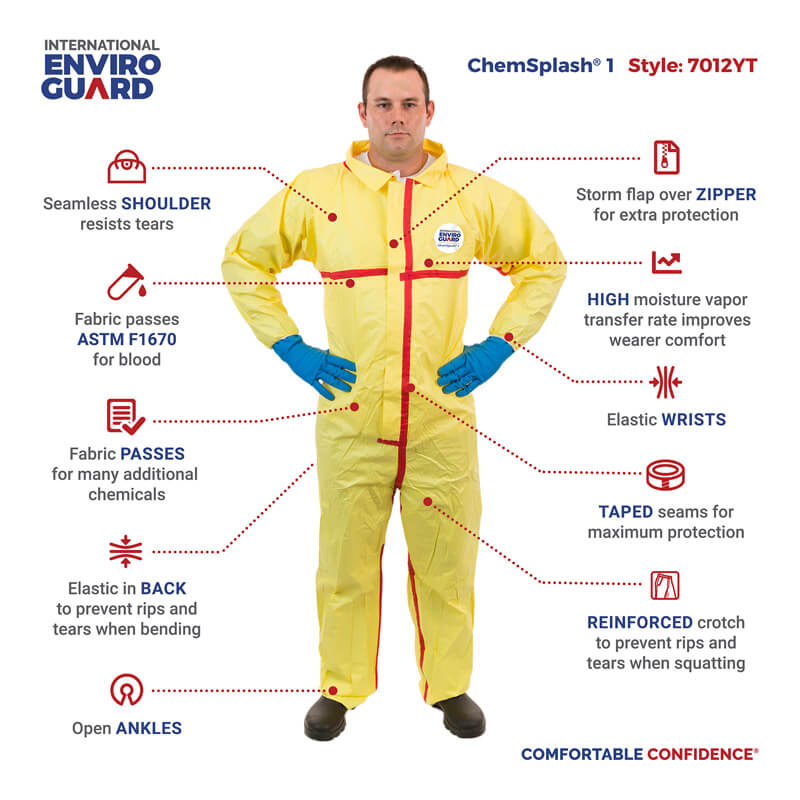
The need for safety precautions for mercury exposure cannot be understated. Mercury in the workplace poses a clear and present danger to the health and wellbeing of individuals in a wide range of industries. Without safeguards such as personal protective equipment (PPE) and disposable gear, this sometimes-unseen toxin can destroy a person’s quality of life.
Inhaling mercury vapors can result in neurological damage, cause cognitive disorders, damage internal organs, and leave victims struggling with uncontrollable tremors for the remainder of their lives. Long-term exposure can prove fatal. International Enviroguard produces mercury PPE that gives working people the protection they deserve. This is what company safety administrators and business leaders need to know about the threat of mercury exposure.
What is Mercury?
It may come as a surprise to people who are fearful about contact with mercury, but it is a naturally occurring element typically embedded in the earth’s crust. It’s particularly prevalent in rocks and coal deposits. Much like lead, mercury ranks among the heavy metals that pose a health risk to people. Rarely does it present as the liquid, silver metal once common in thermometers. Rather, it tends to be bound to other elements such as inorganic salts. There are three common types of mercury.
- Elemental Mercury: This type of metallic mercury has been historically referred to as “quicksilver.” In this pure form, elemental mercury has not interacted with other substances. It presents as a shiny silver liquid at average room temperature and can be found in outdated thermometers, electrical parts, and fluorescent lights, among others. When such products crack or break, liquid mercury escapes and introduces a significant health risk through contact.
- Inorganic Mercury: This type of mercury is abundant as metacinnabar and cinnabar minerals, as well as impurities found in others. It has the capacity to merge with elements such as sulfur and chlorine. As it weathers, it may form inorganic salts. This creates a risk for humans because the mercury salts can infiltrate water or convert into airborne dust particulates.
- Methylmercury: This highly toxic element forms when mercury interacts with bacteria. It was once used as a grain preservative for livestock. In this form, it has the capacity to make physical transformations and cycle through the environment, according to the EPA.
Along with quicksilver, this highly toxic element has garnered names such as “colloidal mercury,” “mercury metal,” and “metallic mercury,” among others. Exposure can occur in wide-reaching ways that include direct contact, inhalation of vaporized mercury, eating tainted foods, or workplace skin contact.
How are People Exposed to Mercury in the Workplace?
Although widespread use of mercury in agriculture, medical equipment, thermometers, construction, and other sectors has been significantly curbed, workers are still inadvertently exposed. Outdated pesticides and equipment are too often laced with mercury, and the demolition of older structures almost ensures some degree of contact. These are common ways today’s unsuspecting workforce comes in direct contact with this toxin.

- Construction: Old light switches, thermostats, transformers, and fluorescent lighting typically include mercury. Today’s workforce rarely considers these and other items dangerous because mercury has been increasingly eliminated from newer machinery and equipment.
- Recycling Sector: People working in this industry routinely encounter old products such as batteries and electronics that are tainted.
- Healthcare Sector: It seems almost counterintuitive, but hazardous mercury was once widely used in medical equipment. Workers who do not enjoy the benefit of modern equipment could be exposed on a daily basis. More modern devices such as blood pressure cuffs and manometers (sphygmomanometers) still contain mercury as the gold standard for accurately gauging blood pressure.
- Energy Sector: Oil and gas personnel are increasingly likely to work with items such as vacuum gauges, barometers, and tanks that have at least trace elements of mercury. Coal-fired powerplants are considered a source of airborne mercury exposure and poisoning. Mercury embedded in coal is typically vaporized, sent into the air, and inhaled by workers without proper protection.
- Agriculture: A wide range of products introduced to the farming industry have been infused with mercury. Among the more prevalent are pesticides, anti-fungal products or fungicides, and feed preservatives.
- Arts Sector: Once a common preservative element, people who work to preserve artwork and taxidermy collections may still be utilizing mercury-infused chemicals.
Although the vast majority of products on the market today no longer include mercury, some loosely regulated imports such as skin creams continue to show traces of mercury. The EPA released a list of products that contain the toxin. The staggering list includes the following.
- Antique Clocks
- Gas-Fired Heaters
- Auto Parts Made as Recently as 2002
- Dental Amalgam
- LCD Screens Monitors
- Imported Jewelry
- Compact fluorescent light bulbs
- High-intensity discharge lamps
- Ultraviolet lamps, neon lights
Workers are often exposed when products are damaged or crushed. The mercury escapes and evaporates into a vapor that is then inhaled. Because it remains odorless and tasteless, rarely are people aware their health may be compromised.
Health Implications of Exposure to Mercury in the Workplace
To say the health and wellness ramifications of mercury exposure are severe would be an understatement. Some health organizations classified the silver, free-flowing liquid as highly toxic and potentially fatal nearly 40 years ago, depending on exposure. These are the common ways exposure to mercury in the workplace occurs and the health risks associated with them.
Mercury Inhalation: Ranked among the most dangerous exposures, people typically experience flu-like symptoms within 3-10 hours. These generally include headaches, fever, tightness in the chest, body aches, and nasal discharge. Although these indicators often fade within 48 hours, exposure could result in life-threatening damage to the lungs. Damage to the nervous system has also been attributed to breathing in mercury vapor, and telltale signs can range from unexplained mood swings to memory loss.
Direct Skin & Eye Contact: Unlike harsh chemicals that result in burns or rashes, mercury contact may not manifest as acutely. Allergic reactions generally present following long-term exposure. However, mercury absorbed through the skin can cause the same damage as inhalation.
Long-Term Exposure: Prolonged mercury exposure may cause permanent and irreversible damage to the nervous system. Workers who have unknowingly been subjected to mercury for extended periods may manifest classic toxicity signatures such as tremors in the hands, eyelids, fingers, and other parts of the body. Many experience significant cognitive and personality changes that can range from irritability or shyness to delirium, hallucination, and psychosis. It’s not uncommon for long-term exposure to result in kidney damage and high blood pressure.
Although long-term exposure requires intensive medical treatment and care, prompt measures are needed when co-workers are inadvertently exposed. Proactive first aid can prevent or minimize mercury absorption in many cases.
First Aid Treatment for Mercury Exposure
It’s critical for workers to wear the PPE needed for mercury exposure prevention. But in cases when people inadvertently come in contact with the toxin, these are ways to deliver first aid, followed by an examination from a health care professional.
- Inhalation Treatment: Responders should wear mercury PPE such as a respirator and move the victim away from the contaminated environment. Get the person to an area where they can take in the fresh air. In the event they experience difficulty breathing, enlist the help of a trained individual to deliver emergency oxygen. Urge the victim to remain calm and not move about unnecessarily. If the victim stops breathing, have a trained person begin cardiopulmonary resuscitation (CPR). Avoid mouth-to-mouth contact by using a guard or a defibrillation unit when possible. Alert poison control in your area and communicate to first responders the victim has been exposed to mercury inhalation.
- Skin Treatment: Workers should always wear appropriate protective clothing to prevent contact with wide-reaching toxins. If you or a colleague sustains a mercury splatter, remove the contaminated clothing immediately. Blot the affected area with a dry cloth and then gently wash the area with moving warm water and liquid soap for a minimum of 5 minutes. Contact a poison control specialist or a doctor.
- Eye Treatment: When working in environments that may harbor toxins, PPE such as face shields are considered standard. If mercury splatters into your eye, flush the impacted eye with warm water for 5 minutes. Keep the eyelid raised throughout the process and call a medical professional for treatment.
When you or a co-worker ingests something containing mercury, rinse the mouth out with warm water and seek immediate medical attention.
Mercury Safety Precautions to Minimize Exposure
The cornerstone of a safe and secure workplace is having high-quality PPE and disposable clothing available for workers. Decision-makers can reduce the risk of exposure to toxins by crafting and distributing safety policies that provide the following.
- Clean-Up: Safety protocols should articulate the precise steps workers take in the event of a mercury release. These typically occur when fluorescent bulbs break, among others. Protective clothing should be utilized at all times, and gloves worn to pick up broken glass.
- Information: Workers should be made aware of the risks of mercury exposure and the need for PPE, such as gowns and masks.
- Separation: Impacted materials should be separated from other trash and recyclables to avoid cross-contamination and inadvertent exposure.
In workplaces that may cause airborne mercury particles and vapors, air quality monitoring should be prioritized. Workers are tasked with adorning protective masks and respirators whenever feasible. When mercury exceeds OSHA's minimal thresholds, employers must establish and enforce a respirator policy.
What Mercury PPE is Necessary for Your Stockpile?
Workplace safety agencies recommend that employees enjoy full access to PPE and disposable protective clothing that includes splash-resistant coveralls, shoe coverings, masks, face shields, goggles, gloves, and other products that protect people from toxins such as mercury. International Enviroguard manufacturers PPE that exceeds industry standards. Along with wide-reaching accessories and products for hazardous work environments, potential products for protection from Mercury include:
- ChemSplash®: This line of protective clothing is lightweight and offers ease of movement. The outer layer provides enhanced protection against chemical splatters and toxic particles that would otherwise make contact with the skin. The proprietary, hybrid membrane fabric offers a high moisture vapor transfer rate (MVTR), so you stay cool as you put in a hard day’s work. A storm flap over the zipper with pressure sensitive tape helps prevent hazardous liquids from entering zipper seams.
ChemSplash® 1
ChemSplash® 2
International Enviroguard products can be accessorized with comfortably fitting gloves, shoe and boot coverings, and disposable masks, among others. This allows company safety officers to order and stockpile disposable clothing that fits firmly and prevents penetrations from hazardous agents such as mercury.
How To Dispose of Mercury PPE Clothing
When working in an industry that may expose workers to mercury or other toxins, PPE disposal protocols must be strictly followed. The result of informally removing protective clothing and accessories can result in exposure and illness. Failing to have a designated space where employees remove the one-time use of products can also lead to mercury transfers. This may cause spouses, adult family members, and children to suffer needlessly. These are proactive measures that can be taken.
- Workers must be afforded a designated decontamination space to remove protective clothing.
- Remove potentially contaminated protective clothing at the end of the workday.
- Disposable protective wear must be placed in a separate bin, typically used for hazardous materials.
- Reusable items can be placed in a bin that only trained personnel access for washing.
- Workers must thoroughly wash before proceeding to a changing room to dress in street clothes.
- Trained personnel must wear protective gloves and other PPE to seal and transport items to the disposal area or washroom, in the case of reusable materials.
- Decontamination space must be effectively cleaned at the end of each shift.
In the event a worker believes they have come in contact with mercury or inhaled particles or vapors, it’s in your best interest to contact a poison control resource and be examined by a doctor promptly. International Enviroguard produces industry-leading protective clothing and accessories suited for wide-reaching industries.
If you require ongoing supplies or are concerned about the possible presence of mercury, contact International Enviroguard for protective solutions.


